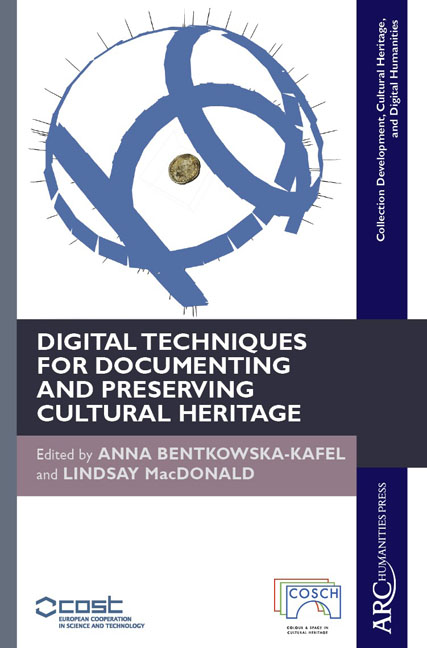Chapter 8 - A Study of Spectral Imaging Acquisition and Processing for Cultural Heritage
Published online by Cambridge University Press: 26 January 2021
Summary
ABSTRACT
Imaging spectroscopy, specifically multispectral (MSI) and hyperspectral (HSI) techniques, has been advanced as an effective non-contact analytical tool for cultural heritage (CH). The combination of digital imaging and spectroscopy results in the ability to map the spatial distribution of materials over an object, extract reflectance spectra for the identification of materials, enhance and reveal underdrawings, identify past conservation treatments, and measure colour. Development and increased application of these techniques to documentation of CH calls for the definition of best practices, to allow institutions to have reproducible and comparable data.
Focusing on spectral object documentation, the Working Group 1 (WG1) of the COST-Action TD 1201, Colour and Space in Cultural Heritage, had the task of identifying, characterising and testing spectral imaging techniques and devices in the 400-2500 nm range. To assess the various spectral imaging systems, WG1 performed a Round Robin Test (RRT). Five objects were recorded by nineteen institutions with various MSI and HSI systems and setups. This coordinated research effort aimed to gain a better understanding of the instrumentation, the elements of data acquisition, and the effects of the instruments and methodology on the accuracy and reliability of the data.
Summarising and visualising the received RRT data illustrated the challenges and complexity of the assessment and comparison of the different datasets. Understanding the variation in the resulting datasets helped to inform best practices for CH. The experience was a means of working towards optimised methodologies to lead to the application of non-contact, high-resolution techniques in the state-of-the-art documentation of CH.
Keywords: Imaging spectroscopy, polychrome surfaces, reflectance, spectral image quality, image colour accuracy, cultural heritage imaging, calibration workflow, multispectral, hyperspectral, COSCH
Introduction
Imaging spectroscopy (IS) techniques, specifically multispectral imaging (MSI) and hyperspectral imaging (HSI), have presented promising advances in the field of non-contact analytical tools for cultural heritage (Fischer and Kakoulli 2006; Cucci et al. 2016). The combination of digital imaging with spectroscopy has expanded point-based, or one-dimensional (1D) spectroscopic techniques. IS provides the ability to distinguish and map the spatial distribution of materials over an entire object, extract reflectance spectra for the identification of materials, calculate colour, enhance and reveal underdrawings, detect changes in composition, and identify damage and past conservation treatments.
- Type
- Chapter
- Information
- Publisher: Amsterdam University PressPrint publication year: 2018
- 2
- Cited by

